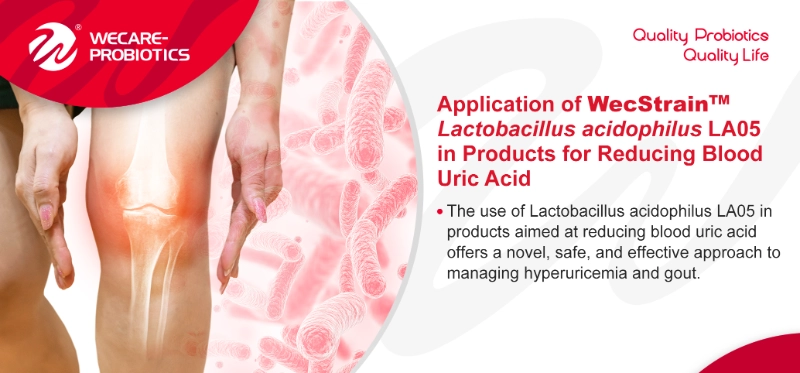
Abstract:
This invention introduces the use of Lactobacillus acidophilus LA05 in preparing products designed to reduce blood uric acid levels. The strain, stored under CGMCC No. 23546, demonstrates survival under low pH and bile salt conditions and has a significant capability to lower blood uric acid. The applications of this probiotic extend to various products, including food, health supplements, and pharmaceuticals, with the potential to treat conditions such as hyperuricemia and gout.
Background:
Hyperuricemia, a chronic disease, is characterized by elevated blood uric acid levels, often leading to gout and associated complications like hypertension, fatty liver, chronic kidney disease, and cardiovascular disorders. Current treatments include medication and purine-restricted diets, but these approaches can have side effects, including liver and kidney damage, gastrointestinal distress, and increased cardiovascular risks. Research has shown that gut microbiota plays a significant role in uric acid metabolism, and manipulating this microflora through probiotics offers a safer and sustainable alternative for managing hyperuricemia and gout.
Key Invention:
This patent presents the use of Lactobacillus acidophilus LA05 in products aimed at reducing uric acid levels in the bloodstream. The strain has been shown to thrive in low-pH environments and in the presence of bile salts, conditions similar to those in the gastrointestinal tract. Its ability to degrade purine precursors (e.g., guanosine and inosine) and inhibit xanthine oxidase, the enzyme responsible for uric acid production, makes it a promising candidate for therapeutic applications.
Strain Properties:
· High survival rate in low pH (pH 2) and 0.3% bile salt conditions.
· Excellent degradation rates of purine precursors like guanosine and inosine, surpassing other known probiotic strains.
· Inhibition of xanthine oxidase activity, comparable to the commonly used drug allopurinol.
Experimental Results:
1. Degradation of Purine Precursors:
o The strain demonstrated superior purine degradation rates, achieving a 100% degradation of guanosine and inosine. This performance is significantly higher compared to other strains like Lactiplantibacillus plantarum.
2. Tolerance to Gastric and Bile Conditions:
o The strain's survival rates under acidic conditions (pH 2) and bile salt concentrations (0.3%) were impressive, with a survival rate of over 90%, indicating its ability to reach the intestines intact.
3. Inhibition of Xanthine Oxidase:
o Lactobacillus acidophilus LA05 showed strong inhibition of xanthine oxidase activity, which is crucial in preventing the formation of uric acid. This effect was dose-dependent and comparable to allopurinol.
4. Animal Studies:
o In animal models, the strain significantly reduced serum uric acid levels, outperforming other single or mixed strains. This suggests its high potential for treating hyperuricemia.
Applications:
1. Food and Health Supplements:
o Lactobacillus acidophilus LA05 can be included in food products such as yogurt, beverages, or solid supplements to help reduce uric acid levels. Its high survival rate during gastrointestinal transit ensures its efficacy in delivering health benefits.
2. Pharmaceuticals:
o This strain can be used in various pharmaceutical forms, including capsules, tablets, and solutions. It can be combined with pharmaceutical excipients like diluents, binders, and flavoring agents to create effective formulations for uric acid reduction.
3. Lyophilized Powders:
o The lyophilized form of Lactobacillus acidophilus LA05, prepared with protective agents such as soybean powder, resistant dextrin, and sodium glutamate, maintains high viability during storage and processing, making it suitable for large-scale industrial production.
Conclusion:
The use of Lactobacillus acidophilus LA05 in products aimed at reducing blood uric acid offers a novel, safe, and effective approach to managing hyperuricemia and gout. Its robust survival under harsh gastrointestinal conditions, along with its superior purine degradation and xanthine oxidase inhibition, makes it a valuable candidate for future therapeutic and health supplement applications.


